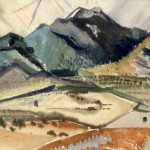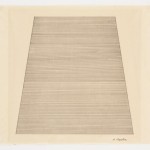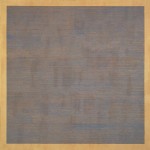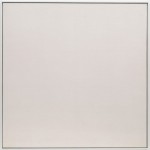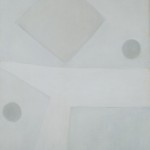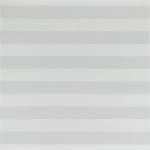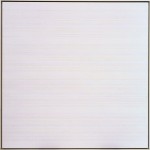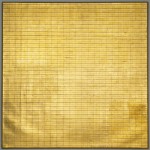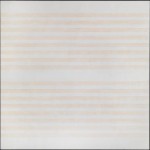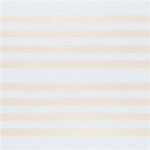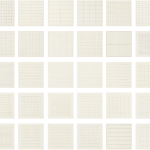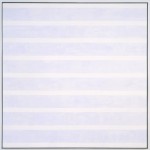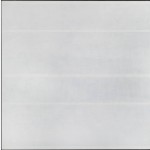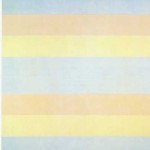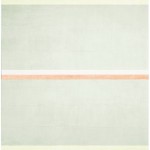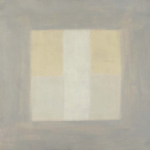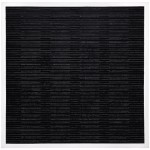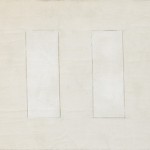Project Description
Biography
Agnes Bernice Martin (March 22, 1912 – December 16, 2004)
American painter of Canadian birth. She grew up in Vancouver and moved to the USA in 1932, taking American citizenship in 1940. She began making art in the early 1940s, while living in New York, where she studied at Columbia University (1941–2, 1951–2) and intermittently in New Mexico, where she studied briefly at the University of New Mexico at Albuquerque (1946–7), also teaching painting there from 1947 to 1948. She returned to New York in 1957, living in Coenties Slip, two blocks of artists’ lofts near South Ferry, where she met other painters such as Ellsworth Kelly, Jack Youngerman (b 1926), Robert Indiana and James Rosenquist while basically living a reclusive life.
Martin held her first one-woman exhibition at the Betty Parsons Gallery in New York in 1958. She constructed her paintings on a rational grid system, superimposing a network of pencilled lines and later coloured bands on fine-grained canvas stained with washes of colour in such a way as to reconcile these apparently antithetical elements. Often the impression is conveyed that the colour is floating off the canvas, with the delicately drawn pencil marks hovering within the edges of the canvas but not quite touching them, as in White Flower (1960; New York, Guggenheim) or Morning (1965; London, Tate). These paintings were influential on the development of Minimalism in the USA, especially on the wall drawings executed in colored pencils by Sol LeWitt, although Martin regarded her use of grids as a development from the ‘all-over’ compositional methods of Abstract Expressionism. She persistently rejected the suggestion that her paintings were conceived in response to the landscape of New Mexico, where she settled again in 1967 and where she chose to work most of her life.
From 1967 Martin concentrated on writing, but when she returned to painting in 1974 she continued refining the idiom that she had established in the early 1960s, favouring geometric structures of uniform bands of evanescent colour in works such as Untitled Number 3 (1974; New York, Pace Gal.; see 1977 exh. cat., p. 16). Her convictions about the emotive content of her work, underlying its apparent reticence and austerity of form, were cogently expressed in a lecture, ‘We Are in the Midst of Reality Responding with Joy’, delivered at Yale University, New Haven, CT, in 1976 (printed in full in 1977 exh. cat., pp. 17–39).
Klaus Ottmann
From Grove Art Online
© 2009 Oxford University Press
SOURCE: OXFORD UNIVERSITY PRESS
Artist Statement
Agnes Bernice Martin (March 22, 1912 – December 16, 2004) was a Canadian-American abstract painter. Often referred to as a minimalist, Martin considered herself an abstract expressionist. She was awarded a National Medal of Arts from the National Endowment for the Arts in 1998.
“I saw the plains driving out of New Mexico and I thought the plain had it just the plane. If you draw a diagonal, that’s loose at both ends. I don’t like circles — too expanding. When I draw horizontals you see this big plane and you have certain feelings like you’re expanding over the plane. Anything can be painted without representation. I don’t believe in influence unless it’s you, yourself following your own track” ”The Untroubled Mind,” Agnes Martin
Biografia
Agnes Bernice Martin (22 marzo 1912 a 16 diciembre 2004). Pintora estadounidense de nacimiento canadiense. Agnes Martin creció en Vancouver y se mudó a los Estados Unidos en 1932 así obteniendo la ciudadanía estadounidense en 1940. Ella comenzó a hacer arte en la década de 1940 mientras vivía en Nueva York donde también estudió en la Universidad de Columbia (1941-2, 1951-2) e intermitentemente en Nuevo México (1946-7). Es alli donde recibe la enseñanza de la pintura desde 1947 hasta 1948. Martin Regresó a Nueva York en 1957 y vivió en Coenties Slip, a dos cuadras de los artistas “lofts” cerca de South Ferry. En esta estadía conoció a otros pintores como Ellsworth Kelly, Jack Youngerman (b 1926), Robert Indiana y James Rosenquist.
Agnes Martin celebró su primera exposición en la galería “Betty Parsons Gallery” de Nueva York en 1958. Ella construyó sus pinturas en un sistema de rejilla racional. Luego realizo la superposición de una red de líneas a lápiz y bandas de color más adelante sobre lienzo de grano fino teñidas con lavados de color para reconciliar estos elementos aparentemente antiestéticos. A menudo, la impresión transmite que el color está flotando fuera del lienzo con las marcas de lápiz delicadamente dibujados flotando dentro de los bordes de la tela como en “la flor blanca” (1960; Nueva York, Guggenheim) o mañana (1965; Londres, Tate). Estas pinturas fueron influyentes en el desarrollo de minimalismo en los Estados Unidos, especialmente en los murales ejecutados en lápices de colores de Sol LeWitt. Aunque Martin miró a su uso de las redes como un desarrollo de los métodos de composición ‘todo-over “del expresionismo abstracto. Ella persistentemente rechazó la sugerencia de que sus pinturas fueron concebidas en respuesta al paisaje de Nuevo México, donde se instaló de nuevo en 1967 y donde se optó por trabajar la mayor parte de su vida.
Desde 1967 Martin se concentró en la escritura, pero cuando regresó a la pintura en 1974, continuó refinando el lenguaje que se había establecido a principios de 1960, a favor de las estructuras geométricas de bandas uniformes de colores evanescentes en obras como Sin título Número 3 (1974; Nueva York , Pace Gal .; ver 1977 exh. cat., p. 16). Sus convicciones sobre el contenido emotivo de su trabajo, que subyacen a su aparente reticencia y la austeridad de la forma, se expresaron de manera convincente en una conferencia: “Nos encontramos en medio de la realidad de responder con alegría ‘, pronunciado en la Universidad de Yale, New Haven, CT, en 1976 (impreso en su totalidad en 1977 exh. cat., pp. 17-39).
Klaus Ottmann
Desde Grove Arte En línea
- Landscape-Taos, c. 1947. (Photo courtesy The Harwood Museum of Art & the Jonson Gallery of the University Art Museum, University of New Mexico, Albuquerque)
- Mountain, 1960. Ruth Vollmer Bequest. © 2012 Estate of Agnes Martin / Artists Rights Society (ARS), New York
- Falling blue, 1963. SFMOMA
- Red Bird, 1964
- Harbor Number 1, 1959. MoMA Collection
- Untitled No. 5, 1975 © Estate of Agnes Martin / DACS, 2009
- Untitled No. 1, 1981
- Petal, 1964
- I Love the Whole World, 1999. Tate Collection/ National Galleries of Scotland. Lent by Anthony d’Offay 2010
- Untitled #6, 1989. MoMA Collection © 2014 Agnes Martin
- Loving love, 2000 © Christies 2007
- On a Clear Day portfolio, 1973 ©PhillipsAuction 2011
- The Tree, 1964 © 2014 Estate of Agnes Martin / Artists Rights Society (ARS), New York
- Faraway Love, 1999 Tate Collection / National Galleries of Scotland
- With my back to the world, 1997. MoMA Collection
- Gratitude, 2001
- Desert Rain, 1957
- Tremolo, 1962. MoMa Collection
- The Sea, 2003
- Untitled, 1959. Solomon R. Guggenheim Museum Collection

